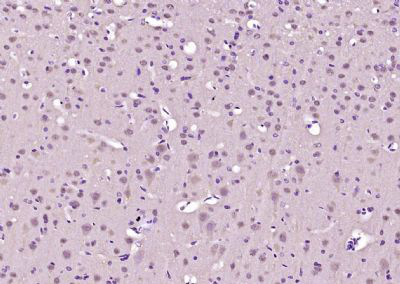产品货号 : mlR12143
英文名称 : SHANK3
中文名称 : 富含脯氨酸突触相关蛋白SHANK3抗体
别 名 : KIAA1650; Proline rich synapse associated protein 2; Proline-rich synapse-associated protein 2; ProSAP2; PSAP2; SH3 and multiple ankyrin repeat domains 3; SH3 and multiple ankyrin repeat domains protein 3; SH3/ankyrin domain gene 3; SHAN3_HUMAN; Shank postsynaptic density protein; Shank3; Shank3b; SPANK 2; SPANK2.
研究领域 : 细胞生物 神经生物学 通道蛋白 细胞粘附分子
抗体来源 : Rabbit
克隆类型 : Polyclonal
交叉反应 : Human, Mouse, Rat, Dog, Pig, Cow, Horse,
产品应用 : ELISA=1:500-1000 IHC-P=1:400-800 IHC-F=1:400-800 ICC=1:100-500 IF=1:100-500 (石蜡切片需做抗原修复)
not yet tested in other applications.
optimal dilutions/concentrations should be determined by the end user.
分 子 量 : 186kDa
细胞定位 : 细胞浆 细胞膜
性 状 : Lyophilized or Liquid
浓 度 : 1mg/ml
免 疫 原 : KLH conjugated synthetic peptide derived from human SHANK3:1151-1250/1741
亚 型 : IgG
纯化方法 : affinity purified by Protein A
储 存 液 : 0.01M TBS(pH7.4) with 1% BSA, 0.03% Proclin300 and 50% Glycerol.
保存条件 : Store at -20 °C for one year. Avoid repeated freeze/thaw cycles. The lyophilized antibody is stable at room temperature for at least one month and for greater than a year when kept at -20°C. When reconstituted in sterile pH 7.4 0.01M PBS or diluent of antibody the antibody is stable for at least two weeks at 2-4 °C.
PubMed : PubMed
产品介绍 : SH3 and multiple ankyrin repeat domains 1-3 (Shank1-3) of the Shank/ProSAP family are molecular scaffolds in the postsynaptic density (PSD). The PSD is an electron-dense structure underneath the postsynaptic plasma membrane of excitatory synapses that anchors and clusters glutamate receptors opposite to the presynaptic neurotransmitter release site. Shank proteins contain PDZ modular domains that coordinate the synaptic localization of ion channels, receptors, signaling enzymes, and cell adhesion molecules. The PDZ domain mediates protein-protein interactions via the recognition of a conserved sequence motif at the C-terminus of their target protein(s). Shank recruits betaPIX and PAK to spines to regulate postsynaptic structure and interacts with NMDA receptor and metabotropic glutamate receptor complexes. Transcript splice variation in the Shank family influences the spectrum of Shank-interacting proteins in the PSDs of adult and developing brain to ensure normal development.
Function:
Seems to be an adapter protein in the postsynaptic density (PSD) of excitatory synapses that interconnects receptors of the postsynaptic membrane including NMDA-type and metabotropic glutamate receptors via complexes with GKAP/PSD-95 and Homer, respectively, and the actin-based cytoskeleton. May play a role in the structural and functional organization of the dendritic spine and synaptic junction.
Subunit:
May homomultimerize via its SAM domain (By similarity). Interacts with DLGAP1/GKAP, MGLUR1A, MGLUR5 C-termini via its PDZ domain (By similarity). Interacts with HOMER1, HOMER2, HOMER3 and CTTN/cortactin SH3 domain (By similarity). Is part of a complex with DLG4/PSD-95 and DLGAP1/GKAP. Interacts with DBNL. Interacts (via PDZ domain) with PROSAPIP1 (via C-terminus) (By similarity). Interacts with BAIAP2.
Subcellular Location:
Cytoplasm (By similarity). Cell junction, synapse (By similarity). Cell junction, synapse, postsynaptic cell membrane, postsynaptic density (By similarity). Note=Postsynaptic density of neuronal cells (By similarity).
Tissue Specificity:
Expressed in the cerebral cortex and the cerebellum.
DISEASE:
Defects in SHANK3 are the cause of schizophrenia type 15 (SCZD15) [MIM:613950]. SCZD15 is a complex, multifactorial psychotic disorder or group of disorders characterized by disturbances in the form and content of thought (e.g. delusions, hallucinations), in mood (e.g. inappropriate affect), in sense of self and relationship to the external world (e.g. loss of ego boundaries, withdrawal), and in behavior (e.g bizarre or apparently purposeless behavior). Although it affects emotions, it is distinguished from mood disorders in which such disturbances are primary. Similarly, there may be mild impairment of cognitive function, and it is distinguished from the dementias in which disturbed cognitive function is considered primary. Some patients manifest schizophrenic as well as bipolar disorder symptoms and are often given the diagnosis of schizoaffective disorder.
SWISS:
Q9BYB0
Gene ID:
85358
Important Note:
This product as supplied is intended for research use only, not for use in human, therapeutic or diagnostic applications.
产品图片












